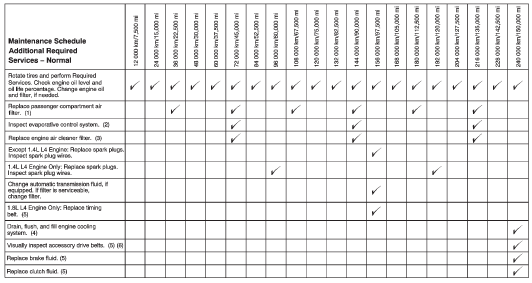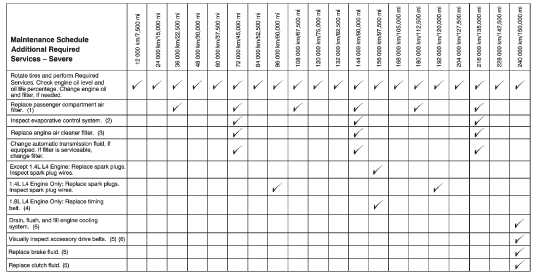Chevrolet Cruze Owners Manual: Maintenance Schedule
Owner Checks and Services
At Each Fuel Stop
Check the engine oil level.
Once a Month
Check the tire inflation pressures.
Inspect the tires for wear.
Check the windshield washer fluid level.
Engine Oil Change
When the CHANGE ENGINE OIL SOON DIC message or Code 82 DIC message displays, have the engine oil and filter changed within the next 1 000 km/600 mi. If driven under the best conditions, the engine oil life system might not indicate the need for vehicle service for more than a year. The engine oil and filter must be changed at least once a year and the oil life system must be reset. Your trained dealer technician can perform this work.
If the engine oil life system is reset accidentally, service the vehicle within 5 000 km/3,000 mi since the last service. Reset the oil life system when the oil is changed.
Tire Rotation and Required Services Every 12 000 km/ 7,500 mi
Rotate the tires, if recommended for the vehicle, and perform the following services.
Check engine oil level and oil life percentage. If needed, change engine oil and filter, and reset oil life system.
Check engine coolant level.
Check windshield washer fluid level.
Visually inspect windshield wiper blades for wear, cracking, or contamination.
Check tire inflation pressures Inspect tire wear.
Visually check for fluid leaks.
Inspect engine air cleaner filter.
Inspect brake system.
Visually inspect steering, suspension, and chassis components for damaged, loose, or missing parts or signs of wear.
Check restraint system components.
Visually inspect fuel system for damage or leaks.
Visually inspect exhaust system and nearby heat shields for loose or damaged parts.
Lubricate body components.
Check starter switch.
Check automatic transmission shift lock control function.
Check ignition transmission lock.
Check parking brake and automatic transmission park mechanism.
Check accelerator pedal for damage, high effort, or binding.
Replace if needed.
Visually inspect gas strut for signs of wear, cracks, or other damage. Check the hold open ability of the strut. See your dealer if service is required.
Check tire sealant expiration date, if equipped.
Inspect sunroof track and seal, if equipped.

Footnotes Maintenance Schedule Additional Required Services Normal
(1) Or every two years, whichever comes first. More frequent replacement may be needed if the vehicle is driven in areas with heavy traffic, areas with poor air quality, or areas with high dust levels.
Replacement may also be needed if there is a reduction in air flow, excessive window fogging, or odors.
(2) Check all fuel and vapor lines and hoses for proper hook-up, routing, and condition. Check that the purge valve, if the vehicle has one, works properly. Replace as needed.
(3) Or every four years, whichever comes first.
(4) Or every five years, whichever comes first.
(5) Or every 10 years, whichever comes first.
(6) Inspect for fraying, excessive cracking, or damage; replace, if needed.

Footnotes Maintenance Schedule Additional Required Services Severe
(1) Or every two years, whichever comes first. More frequent replacement may be needed if the vehicle is driven in areas with heavy traffic, areas with poor air quality, or areas with high dust levels.
Replacement may also be needed if there is a reduction in air flow, excessive window fogging, or odors.
(2) Check all fuel and vapor lines and hoses for proper hook-up, routing, and condition. Check that the purge valve, if the vehicle has one, works properly. Replace as needed.
(3) Or every four years, whichever comes first.
(4) Or every five years, whichever comes first.
(5) Or every 10 years, whichever comes first.
(6) Inspect for fraying, excessive cracking, or damage; replace, if needed.
 General Information
General Information
Your vehicle is an important investment. This section describes the required
maintenance for the vehicle. Follow this schedule to help protect against major
repair expenses resulting from neglect ...
 Special Application Services
Special Application Services
Severe Commercial Use Vehicles Only: Lubricate chassis components every 5 000
km/ 3,000 mi.
Have underbody flushing service performed once a year. ...
Other materials:
New Vehicle Break-In
Notice: The vehicle does not need an elaborate break-in. But it will
perform better in the long run if you follow these guidelines:
Do not drive at any one constant speed, fast or slow, for the first 805 km (500
mi).
Do not make full-throttle starts. Avoid downshifting to brake or slow the v ...
Power Outlets
The accessory power outlets can be used to plug in electrical equipment, such
as a cell phone or MP3 player.
There is one accessory power outlet located on the center floor console and one
on the rear of the center floor console. These outlets are powered when the key
is in ON/ RUN or ACC/ACC ...
Installation Procedure
Align the rear compartment floor panel.
Drill 4 mm (3/16 in) for rivets along the edges of the rear compartment
floor were you cant apply a resistance spot welder.
Clean and prepare the attaching surfaces for
spot welding and riveting.
Apply structural adhesive to all a ...
